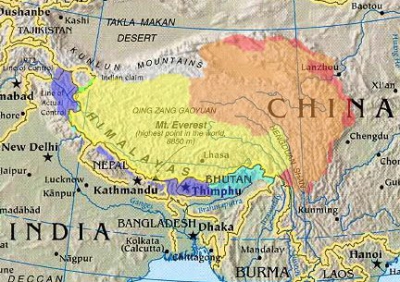The Seventeen Point Agreement is a short form of the Agreement of the Central People's Government and the Local Government of Tibet on Measures for the Peaceful Liberation of Tibet, (Chinese: ; Tibetan: ) or the Seventeen Point Agreement for the Peaceful Liberation of Tibet which was signed by the plenipotentiaries of the Tibetan Government in Lhasa and the plenipotentiaries of the Central People's Government on 23 May 1951, and ratified by the 14th Dalai Lama in the form of a telegram on 24 October 1951.In September 1951, the United States informed the Dalai Lama that in order to receive assistance and support from the United States, he must depart from Tibet and publicly disavow "agreements concluded under duress" between the representatives of Tibet and Chinese Communists. On 18 April 1959, the 14th Dalai Lama issued the statement that the agreement was made under pressure of the Chinese Government. The Central Tibetan Administration which was formed after 1960 considers the agreement invalid. German legal scholar Eckart Klein considers the agreement invalid and as having been signed under duress. Ngapoi Ngawang Jigme, head of the Tibetan Delegation to the Beijing Peace Negotiations, reported that there was no duress involved. A. Tom Grunfeld pointed out that the unabashed adulation in the poem written by the 14th Dalai Lama hardly demonstrates someone unhappy with the Chinese presence in Tibet.
Tibet ( (listen); Tibetan: བོད་, Lhasa dialect: [pʰøː˨˧˩]; Chinese: 西藏; pinyin: Xīzàng) is a region in East Asia covering much of the Tibetan Plateau spanning about 2,500,000 km2 (970,000 sq mi). It is the traditional homeland of the Tibetan people as well as some other ethnic groups such as Monpa, Tamang, Qiang, Sherpa and Lhoba peoples and is now also inhabited by considerable numbers of Han Chinese and Hui people. Tibet is the highest region on Earth, with an average elevation of 4,380 m (14,000 ft). Located in the Himalayas, the highest elevation in Tibet is Mount Everest, Earth's highest mountain, rising 8,848.86 m (29,032 ft) above sea level.The Tibetan Empire emerged in the 7th century. At its height in the 9th century, the Tibetan Empire extended far beyond the Tibetan Plateau, from Central Asian's Tarim Basin and the Pamirs in the west to Yunnan and Bengal in the southeast. But once the process of fragmentation began, the empire divided into a variety of territories. The bulk of western and central Tibet (Ü-Tsang) was often at least nominally unified under a series of Tibetan governments in Lhasa, Shigatse, or nearby locations. The eastern regions of Kham and Amdo often maintained a more decentralized indigenous political structure, being divided among a number of small principalities and tribal groups, while also often falling more directly under Chinese rule; most of this area was eventually annexed into the Chinese provinces of Sichuan and Qinghai. The current borders of Tibet were generally established in the 18th century.Following the Xinhai Revolution against the Qing dynasty in 1912, Qing soldiers were disarmed and escorted out of Tibet Area (Ü-Tsang). The region subsequently declared its independence in 1913 without recognition by the subsequent Chinese Republican government. Later, Lhasa took control of the western part of Xikang, China. On 26 January 1940, the Regent Reting Rinpoche requested the Central Government of China to exempt Lhamo Dhondup from lot-drawing process using Golden Urn to become the 14th Dalai Lama. The request was approved by the Central Government. The region maintained its autonomy until 1951 when, following the Battle of Chamdo, Tibet was occupied and annexed into the People's Republic of China, and the previous Tibetan government was abolished in 1959 after a failed uprising. Today, China governs western and central Tibet as the Tibet Autonomous Region while the eastern areas are now mostly ethnic autonomous prefectures within Sichuan, Qinghai and other neighbouring provinces. There are tensions regarding Tibet's political status and dissident groups that are active in exile.
Tibetan activists in Tibet have reportedly been arrested or tortured.The economy of Tibet is dominated by subsistence agriculture, though tourism has become a growing industry in recent decades. The dominant religion in Tibet is Tibetan Buddhism; other religions include Bön, an indigenous religion similar to Tibetan Buddhism, Tibetan Muslims, and Christian minorities. Tibetan Buddhism is a primary influence on the art, music, and festivals of the region. Tibetan architecture reflects Chinese and Indian influences. Staple foods in Tibet are roasted barley, yak meat, and butter tea.

1951Apr, 29
Tibetan delegates to the Central People's Government arrive in Beijing and draft a Seventeen Point Agreement for Chinese sovereignty and Tibetan autonomy.
Choose Another Date
Events on 1951
- 11Apr
President Truman's relief of General Douglas MacArthur
Korean War: President Harry Truman relieves General of the Army Douglas MacArthur of overall command in Korea. - 22Apr
Battle of Kapyong
Korean War: The Chinese People's Volunteer Army begin assaulting positions defended by the Royal Australian Regiment and the Princess Patricia's Canadian Light Infantry at the Battle of Kapyong. - 25Apr
Battle of Kapyong
Korean War: Assaulting Chinese forces are forced to withdraw after heavy fighting with UN forces, primarily made up of Australian and Canadian troops, at the Battle of Kapyong. - 3May
Harry Truman
The United States Senate Committee on Armed Services and United States Senate Committee on Foreign Relations begin their closed door hearings into the dismissal of General Douglas MacArthur by U.S. President Harry Truman. - 15Oct
Combined oral contraceptive pill
Mexican chemist Luis E. Miramontes conducts the very last step of the first synthesis of norethisterone, the progestin that would later be used in one of the first three oral contraceptives.

 English
English  español
español  français
français  português
português  русский
русский  العربية
العربية  简体中文
简体中文 